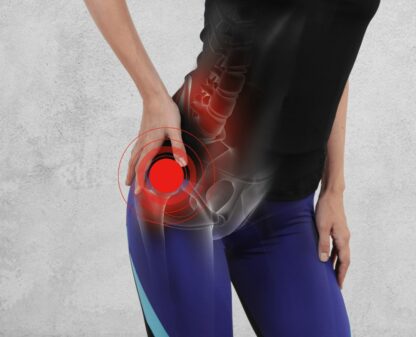Improving Function in People with Hip-Related Pain

Introduction
As for many musculoskeletal disorders first-line physiotherapy treatment is recommended, this study aimed to assess its effectiveness in improving pain and function in young and middle-aged subjects (18-50 years) with hip-related pain (with or without a diagnosis of femoroacetabular impingement syndrome). A methodologically strong systematic review with meta-analysis was conducted.
Methods
A systematic review with meta-analysis following the PRISMA guidelines was conducted. The review included 14 publications and 10 RCTs were used in the quantitative synthesis.
Results
Physiotherapy versus sham/no treatment:
Targeted strengthening interventions lasting 3 months produced moderate pooled effects favoring physiotherapy (0.66; 95% CI (0.09 to 1.23) in patients treated non-surgically. No significant effects were found for interventions of shorter duration (6-8 weeks). The level of evidence therefore was limited since it came forward from pilot RCTs.
Moderate positive effects for patient-reported function favoring physiotherapy in patients post-arthroscopy were found (0.67; 95% CI 0.07 to 1.26), however, the evidence was limited since this finding was based on 2 pilot RCTs that couldn’t be pooled (due to heterogeneity in outcome measurements). Both studies reached follow-up scores higher than the PASS and MIC scores, but there was wide variability in the proportion of people reaching those scores (ranging from 11%-90%).

Physiotherapy versus hip arthroscopy:
Strong evidence found weak effects at 8-12 months favoring hip arthroscopy (-0.32; 95% CI -0.57 to -0.07). However, this effect was small and not considered clinically meaningful. Besides this, physiotherapy was far more cost-effective compared to hip arthroscopy (£155 for physiotherapy versus £2372 for hip arthroscopy).

Within-group changes for PROMs and physical impairments with physiotherapy:
Moderate evidence found moderate effects for patient-reported function (0.57; 95% CI 0.03 to 1.12) after 3 months of physiotherapy and large positive effects for function (3.85; 95% CI 2.91 to 4.78) after 6 months of physiotherapy. However, due to the inability to pool these effects (heterogeneity in outcome measures and time points), caution in interpreting these results is warranted. The proportion of patients achieving scores beyond the PASS scores ranged from 26%-86%.
For impairments, the level of evidence was limited and pooling was impossible.
- For hip flexion range of motion (ROM) effects ranged from large negative changes (2.07, 95% CI –2.64 to −1.50) following 6 months of rest, stretching, and activity modification to large positive changes (1.08, 95% CI 0.49 to 1.68) following 3 months of strengthening exercise, manual therapy, and education.
- For hip muscle strength effects ranged from weak, non-significant effects (0.09,–0.35 to 0.53) after 10 weeks of progressive strengthening exercises, to large positive SMDs (1.19, 0.57 to 1.81) after 12 weeks of strengthening and functional retraining
- Functional task performance effects ranged from moderate improvements in the timed chair climb test (0.57, 95% CI 0.10 to 1.05), single-leg hop test (0.65, 95% CI 0.12 to 1.17), and Y-balance test (0.63, 95% CI 0.29 to 0.97) with movement retraining and functional exercise programs, to large improvements for trunk endurance (0.95, 95% CI 0.38 to 1.53) following 3 months of targeted trunk strengthening.
Talk nerdy to me
Several good points can be noted. First of all, the methodology was established a priori to minimize selection bias. Secondly, the authors performed a thorough search including alternative searches of grey literature and reference lists. To minimize mistakes, two independent reviewers were responsible for the selection of studies, data extraction, and analysis. Further, studies from lower quality (level evidence IV on) were included but the authors ascertained the high-quality evidence of this review by only using studies with a control intervention to summarize the main findings. Lastly, follow-up scores were compared with the Patient’s Acceptable Symptom State (PASS) and minimal important change (MIC) scores to provide some context to the clinical relevance of the reported effects.
Some limitations include that only one-third of included studies received a low risk of bias rating. Furthermore, several included RCTs were pilot studies and therefore it may be possible that these were underpowered, and thus unable to detect group differences. On top of that, heterogeneity in the included populations was present. Due to including only English-language articles in the review, inclusion bias may have impacted the results. The PASS and MIC scores were previously determined in studies examining patients with hip pathologies treated surgically, so it is not clear whether these scores also reflect conservative thresholds.
To sum it up, physiotherapy may improve function and strength in young to middle-aged adults. Limited evidence indicates that targeted strengthening programs of at least 3 months duration might achieve the best results. A small advantage of arthroscopy after 8-12 months that is not clinically meaningful does not outweigh the better cost-effectiveness and higher safety of physiotherapy. Furthermore, limited evidence found this small benefit favoring arthroscopy was not present at 24 months. Physiotherapy mainly consisted of exercise therapy, but full-scale RCTs are required to study the optimal components of rehabilitation programs.
Take home messages
To date, the best evidence suggests physiotherapy should be the first-line treatment for hip pain in young and middle-aged subjects. Physiotherapy improves function and strength and may exert effects on physical impairments. The largest effects for hip ROM were seen after an intervention of 3 months consisting of strengthening exercises, manual therapy, and education. A strengthening program of 3 months led to the largest gain in hip muscle strength, particularly in the hip adductors. Given that an earlier study found this to be related to better hip-related QOL, the authors indicate targeting the adductors may be an important aspect of rehabilitation.
Reference
LEVEL UP YOUR DIFFERENTIAL DIAGNOSIS IN RUNNING RELATED HIP PAIN - FOR FREE!
Don’t run the risk of missing out on potential red flags or ending up treating runners based on a wrong diagnosis! This webinar will prevent you to commit the same mistakes many therapists fall victim to!



